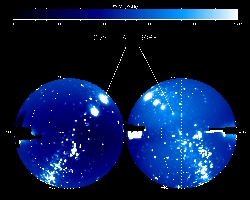SOHO/SWAN Ultraviolet Image of Comet Hale-Bopp Approaching the Sun A time series of 6 images of comet Hale-Bopp taken by the SWAN instrument on board SOHO in the ultraviolet light (110-180 nm), on January 4, February 2 and 18, March 4 and 16, and April 3, 1997, as the comet slowly approaches the Sun, and increases in brightness. Hale-Bopp is clearly visible because of its huge hydrogen cloud produced by photo-dissociation of water vapor molecules evaporated from the solid nucleus. This nucleus is composed of ice and dust and has an estimated diameter of about 40 km. In contrast, the hydrogen cloud is more than 100 million kilometers across, which makes it the largest object in the solar system. The analysis of SWAN data of the hydrogen cloud indicates that about 600 tons of ice are vaporized and ejected in space each second during closest approach, forming its brilliant tail, until recently clearly visible in the night sky. Credits: SOHO (SWAN consortium), ESA, NASA. SWAN: Service d'Aeronomie du CNRS (France), Finnish Meteorological Institute (Finland) SOHO is a project of international cooperation between ESA and NASA.
Downloads
- Full-size image [JPG, 320K]
- Medium-size image [JPG, 33K]
- Hi-resolution size image [TIF, 784K]
- Medium-size image [JPG, 33K]



